Falun
Gong is a special Buddhist cultivation practice. It has unique parts that
distinguish it from other regular Buddhist cultivation methods. Falun Gong is
an advanced system of cultivation. In the past it was a rigorous cultivation
method that demanded that its practitioners have extremely high character or
great spiritual inclination. For this reason the system of cultivation was
hard to share with the public. But in order for more people to come to know
this cultivation system, to raise their levels, and to meet the needs of
numerous, devoted cultivators, I compiled a set of cultivation exercises
suitable for the public. In spite of the modifications, these exercises still
far exceed those of average cultivation systems in terms of their offerings
and the levels at which they are practiced.
Falun
Gong cultivators can not only quickly develop their gong strength and
supernatural abilities, but also acquire an incomparably powerful Law Wheel in
a very short period of time. Once formed, the Law Wheel perpetually rotates
automatically in a practitioner’s lower abdomen. It continuously collects
energy from the universe and transforms it into gong in the
cultivator’s innate body. The goal called “the Law refines the practitioner”
is thus achieved.
Falun Gong has five sets of movements. They are the following exercises: Buddha
Stretching a Thousand Arms, Falun Standing Stance, Coursing Between the Two
Poles, Falun Cosmic Orbit, and Reinforcing Supernatural Powers.
1. Buddha Stretching a Thousand Arms
(Fo Zhan Qianshou Fa)[1]
Principle:The
core of Buddha Stretching a Thousand Arms is stretching to open up all energy
channels. Through doing this exercise, beginners can acquire energy in a short
period of time, and experienced practitioners will improve quickly. The
exercise requires all energy channels to be opened up at the outset, enabling
practitioners to immediately practice at a high level. The movements of this
exercise are quite simple because a Great Way is, as a rule, simple and easy
to learn. Though the movements are simple, they dictate everything involved in
the cultivation system. When doing this exercise, one’s body will feel warm
and will experience a unique sensation of there being a very strong energy
field. This is caused by stretching and opening all the energy channels
throughout the body. The purpose is to break through areas where the energy is
blocked, to enable energy to circulate freely and smoothly, to mobilize the
energy within the body and under the skin, circulating it vigorously, and to
absorb a great amount of energy from the universe. It simultaneously enables
the practitioner to quickly achieve the state of having a qigong
energy field. This exercise is done as the foundational exercise of Falun
Gong, and it is usually done first. It is one of the methods for reinforcing
your cultivation.
Verse:[2]
Shenshen Heyi[3]
Dongjing Suiji[4]
Dingtian Duzun[5]
Qianshou Foli[6]
Preparation
– Relax
the entire body, but don’t become too loose. Stand naturally, with feet
shoulder-width apart. Bend the knees slightly. Keep the knees and hips
relaxed. Tuck your chin in slightly. Touch the tip of the tongue to the hard
palate. Leave a little space between the teeth. Close the lips and gently shut
the eyes. Maintain a serene expression on the face. During the exercise you
will have the feeling that you are very large and tall.
Conjoining the Hands (Liangshou Jieyin)[7] –
Lift both hands slightly with the palms facing up. Have the thumb tips lightly
touch each other. Let the other four fingers of each hand meet and overlap
on top of each other. For males the left hand is on top; for females the right
hand is on top. Have the hands form an oval shape and hold them at the lower
abdominal area. Hold both upper arms slightly forward with the elbows suspended
so that the underarms are open (see Figure 1-1).




Buddha
Maitreya Stretching His Back (Mile Shenyao)[8] –
Begin with hands conjoined (Jieyin).
While raising the conjoined hands, straighten both legs gradually. When the
hands reach the front of the face, separate them and gradually turn both palms
upward. Once the hands are above the top of the head, have the palms face up
and the fingers of both hands point toward each other, with a distance of
20-25 cm (8-10 inches) between them (Fig. 1-2). At the same time, push the
head upward and press the feet downward on the ground. Press up hard with the
heels of both palms and stretch the body for about 2 to 3 seconds. Then relax
the whole body abruptly; remember to bring the knees and hips back to a
relaxed position.
Tathagata[9] Pouring
Energy into the Top of the Head (Rulai
Guanding)[10] –
Following
from the above posture, turn your palms outward 140° to both sides
simultaneously, so that the insides of the wrists face each other, forming a
funnel shape. Straighten the wrists and move them downward (Fig. 1-3). When
the hands reach the front of the chest, have the palms face the chest at a
distance of about 10 cm (4 inches). Continue moving both hands down until they
reach the lower abdomen (Fig. 1-4).
Pressing
the Hands Together in Front of the Chest (Shuangshou
Heshi)[11] –
When reaching the lower abdominal area, without pausing, lift the hands up to
the chest and press them together (Heshi) (Fig. 1-5). When doing
Heshi, press both the
fingers and the heels of the palms against each other, keeping a hollow space
between the palms. Hold the elbows up, with the forearms forming a straight
line. (Keep hands in the Lotus Palm position, [12]
except
when putting hands together (Heshi)
or conjoining them (Jieyin); the
same applies to the following exercises.)




Hands
Pointing to Heaven and Earth (Zhangzhi Qiankun)[13]
- Starting
from the posture of Heshi, separate the hands 2-3 cm (1 inch) and start
to turn them. Males turn the left hand (females, the right hand) towards the
chest and turn the other hand outwards, so that the left hand is on top and
the right hand is on the bottom (for females, the opposite). Both hands should
make a straight line with the forearms (Fig. 1-6).
Next, extend the top forearm diagonally upward with the palm
facing down, until the hand reaches the level of the head. Keep the other hand
at the chest with the palm facing up. As the top arm extends, stretch the
entire body gradually, push the head upward, and press the feet downward.
Stretch the top arm upward in the upper left direction (females, the right
direction), while the arm that is in front of the chest stretches outward
along with the raised arm (Fig. 1-7). Stretch for about 2 to 3 seconds, then
relax the entire body abruptly. Bring the raised arm down to the front of the
chest and to Heshi. Next, turn the palms again. The right hand
(females, the left hand) is on top and the left hand is at the bottom (Fig.
1-8). The top arm repeats the previous movements just done; that is, extend
the forearm diagonally upward with the palm facing down, until the hand has
reached as high as the head. Keep the other arm at the chest with the palm
facing upward. After stretching (Fig. 1-9), relax the entire body abruptly.
Bring the hands to the front of the chest and put them together in
Heshi (Fig. 1-5).
Golden
Monkey Splitting Its Body (Jinhou Fenshen)[14]
– Begin with the posture of Heshi. Separate the hands at the chest and
extend them outward to the sides of the body, forming a straight line with the
shoulders. Gradually stretch the entire body. Push the head upward, press the
feet downward, and stretch the arms hard out to the sides. Stretch in these
four directions (Fig. 1-10) for 2-3 seconds. Relax the entire body abruptly
and put the hands together in Heshi.



Two
Dragons Diving into the Sea (Shuanglong Xiahai)[15] –
From Heshi, separate the hands and extend them downward towards the
lower front of the body. When the arms are parallel and straight, they should
form an angle of about 30° with the legs (Fig. 1-11). Stretch the whole body.
Push the head upward and press the feet downward. Stretch for about 2-3
seconds, then relax the entire body abruptly. Draw back the hands and put them
together in Heshi.
Bodhisattva Touching
the Lotus(Pusa Fulian)[16] –
From Heshi, separate the hands and extend them diagonally downward to the sides
of the body, with the angle between the arms and the legs at about 30° (Fig.
1-12). Stretch the whole body gradually, while the fingertips stretch out
downward with a little force. Then, relax the entire body abruptly. Bring the
hands toward the chest and put them together in Heshi.
Arhat
Carrying a Mountain on His Back (Luohan Beishan)[17]
– Begin
with the hands in Heshi. Separate the hands and extend them behind the
body. At the same time, turn both palms to face backward. When the hands are
passing the sides of the body, slowly flex the wrists. When the hands reach
behind the body, the angle between the wrists and the body should be 45° (Fig.
1-13). Stretch the entire body gradually. After the hands reach the proper
position, push the head upward and press the feet downward. Keep the body
upright, and stretch for about 2-3 seconds. Relax the entire body abruptly.
Draw back the hands and return them to Heshi.


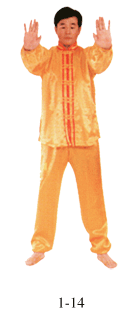

Vajra[18] Toppling
a Mountain (Jingang
Paishan)[19] –
Begin with the hands in Heshi, then separate them and push forward with
the palms. Have the fingers pointing upward and keep the arms at shoulder
level. Once the arms are straight, push the head upward and press the feet
downward. Keep the body upright (Fig. 1-14). Stretch for 2-3 seconds, then
relax the entire body abruptly. Put the hands together in front of the chest
to form Heshi.
Overlapping
the Hands in Front of the Lower Abdomen (Diekou Xiaofu)[20] –
Begin with the hands in Heshi. Slowly move the hands downward, turning
the palms to face the abdominal area. When the hands reach the lower abdominal
area, overlap them. For males, the left hand goes on the inside; for females,
the right hand goes on the inside. Have the palm of the outer hand facing the
back of the inner hand. Keep a distance of 3 cm (1 inch) between the hands and
another 3 cm (1 inch) between the inner hand and the lower abdomen. Usually
the hands are kept this way for 40 to 100 seconds (Fig. 1-15). Finish the
exercise by conjoining the hands in the Jieyin position.
2. Falun Standing Stance
(Falun Zhuang Fa)[21]
Principles:
This is the second Falun Gong exercise. It is a still, standing
exercise composed of four wheel-holding positions. There are few movements and
each position needs to be held for quite a while. Beginners’ arms might
initially feel heavy and achy. After doing the exercise, though, the whole
body will feel relaxed, without feeling any of the fatigue that comes from
physical work. When practitioners increase the frequency and duration of the
exercise, they can feel a Law Wheel rotating between their arms. Doing the
Falun Standing Stance exercise frequently will help open the entire body
completely, and it will enhance gong strength. Falun Standing Stance is a
comprehensive means of cultivation that increases wisdom, raises a person’s
level, and strengthens supernatural powers. The movements are simple, yet much
can be achieved from this exercise and nothing is left out. During the
exercise, do the movements naturally—you must be aware that you are doing
them, and don’t sway, though it is normal to move slightly. As with the other
exercises of Falun Gong, the end of this exercise does not mean the end of the
practice since the Law Wheel never stops rotating. The duration of each
movement can differ from person to person, but the longer, the better.
Verse:
Shenghui Zengli[22]
Rongxin Qingti[23]
Simiao Siwu[24]
Falun Chuqi[25]
Preparation
– Relax the whole body, but don’t become too loose. Stand
naturally, with feet shoulder-width apart. Bend the knees slightly. Keep the
knees and hips relaxed. Tuck your chin in slightly. Touch the tip of the
tongue to the hard palate. Leave a little space between the teeth. Close the
lips and gently close the eyes. Maintain a serene expression on the face.
Conjoin the hands in Jieyin.
Holding the Wheel in Front
of the Head (Touqian Baolun)[26] – Start with the hands in Jieyin. Slowly raise both hands from the lower
abdomen, separating them in the process. When the hands have reached the front
of the head, have the palms point toward the face at eyebrow level. Have the
fingertips of the hands point toward each other, with 15 cm (5 inches) between
them. Form a circle with the arms and relax the whole body (Fig.
2-1).
Holding the Wheel in Front
of the Lower Abdomen (Fuqian Baolun)[27] – Slowly bring both hands downward
from the previous position. Keep the wheel-holding position unchanged as they
reach the lower abdominal area. Keep a distance of about 10 cm (4 inches)
between the hands and the abdomen. Hold the elbows forward, keeping the
underarms open. Have the palms face up and the fingers of the hands point
toward each other, with a distance of 10 cm (4 inches) between them. The arms
should form a circle (Fig. 2-2).




Holding the Wheel Above the
Head (Touding Baolun)[28] – From the previous position, raise the arms slowly,
keeping the circular shape unchanged. Hold the wheel above the head with the
fingers pointing toward each other. Keep the palms facing downward, with a
distance of 20-30 cm (8-12 inches) between the fingertips of the hands. The
arms should form a circle. Keep the shoulders, arms, elbows and wrists relaxed
(Fig. 2-3).
Holding Wheels on Both Sides of the Head
(Liangce Baolun)[29] – Starting from the previous position, slowly move the hands downward to the sides of the head.
Keep the palms facing the ears, the forearms upright, and the shoulders
relaxed. Don’t hold the hands too close to the ears (Fig.
2-4).
Overlapping the Hands in
Front of the Lower Abdomen (Diekou Xiaofu) – Slowly move both hands down from
the previous position to the lower abdomen. Overlap the hands (Fig. 1-15).
Finish the exercise by doing Jieyin).
3. Coursing Between the Two Poles
(Guantong Liangji Fa)[30]
Principles:
The purpose of this exercise is to mix and merge the
universe’s energy with the energy inside the body. A great amount of energy is
expelled and taken in. In a very short time, the practitioner can expel the
pathogenic and black qi from his or her body and
take in a great deal of energy from the universe, enabling the body to be
purified and to quickly reach the state of “a Pure-White Body.” Also, while
the arms are moving up and down, the exercise facilitates the “opening of the
top of the head” and unblocks the passages under the feet.
Before doing the exercise, picture yourself as two large
empty barrels standing upright between heaven and earth, gigantic and
incomparably tall. With the upward movement of the arms, the qi in the body rushes directly out of the top of the
head to the upper pole of the universe; with the downward movement of the
arms, it goes out through the bottoms of the feet to the lower pole of the
universe. After these movements of the arms, the energy returns to the inside
of the body from both poles, and is then sent out in the opposite direction.
The arms are moved up and down in opposite directions nine times each. On the
ninth movement, the left arm is held up (females, the right arm) and kept
there, then the other arm is brought up. Next, both arms move downward
together, bringing the energy to the lower pole, and then back to the upper
pole as they move along the body. After the arms move up and down nine times,
the energy is brought back into the body. The Law Wheel is turned clockwise
(as viewed from the front) at the lower abdomen four times to spin the energy
that is outside the body back in. The hands are conjoined in Jieyin to end the exercise, but not the functioning
of gong.
Verse:
Jinghua Benti[31]
Fakai Dingdi[32]
Xinci Yimeng[33]
Tongtian Chedi[34]
Preparation
– Relax the entire body, but don’t become too loose. Stand
naturally, with feet shoulder-width apart. Bend the knees slightly. Keep the
knees and hips relaxed. Tuck your chin in slightly. Touch the tip of the
tongue to the hard palate. Leave a little space between the teeth. Close the
lips and gently close the eyes. Assume a serene expression on the face.
Conjoin the hands in Jieyin, then put them
together in Heshi in front of the
chest.
Singular Up-and-Down Arm
Movement (Danshou Chong’guan)[35] – From the Heshi posture, the exercise
starts with singular arm movement in which the arms glide slowly along with
the energy mechanisms outside the body. Following along with the movements of
the arms, the energy inside the body flows up and down continuously. For
males, bring the left arm up first (Fig. 3-1); for females, bring the right
arm up first. Slowly bring up the arm, passing along the front side of the
face and extending it above the top of the head. Simultaneously, slowly lower
the other arm. Keep alternating the arms in this way (Fig. 3-2). Keep both
palms facing toward the body at a distance of 10 cm (4 inches). When doing the
exercise keep the entire body relaxed. One up-and-down movement of the arms is
counted as one time. Repeat a total of nine times.




Double Up-and-Down Arm
Movement (Shuangshou Chong'guan)[36] – At the ninth
singular-arm movement, the left arm (females, the right arm) stays up and
waits while the other arm is brought up. Both hands are pointing upward (Fig.
3-3). Next, move both arms downward at the same time (Fig. 3-4). Keep the
palms facing the body at a distance of 10 cm (4 inches).
One up-and-down movement of the arms is counted as one time. Repeat
nine times.
Turning the Law Wheel With
Both Hands (Shuangshou Tuidong Falun)[37] – After completing the double-arm movements, move both arms
downward past the face and over the chest until reaching the location of the
lower abdomen. Now turn the Law Wheel at the lower abdomen (Fig. 3-5, 3-6, and
3-7), with the left hand inside for males and the right hand inside for
females. Keep a distance of 3 cm (1 inch) between the hands and between the inner
hand and the lower abdomen. Turn the Law Wheel clockwise (as viewed from the
front) four times to spin the energy from outside back to the inside of the
body. When turning the Law Wheel, keep the movements of the hands within the
area of the lower abdomen.


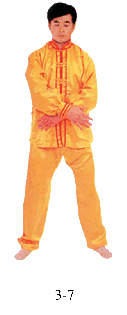
Conjoin the
Hands(Liang Shou Jieyin) (Fig. 1-1)
4. Falun Cosmic Orbit
(Falun Zhoutian Fa)[38]
Principles:
This exercise enables the human body’s energy to
circulate over large areas. Rather than going through only one or several
meridians, the energy circulates from the entire yin side of the body to the yang side, over and over again. This exercise goes
far beyond the usual methods of opening up the meridians and the great and
small cosmic orbits. It is one of Falun Gong’s intermediate-level exercises.
With the previous three exercises as a base, this one is intended to open up
all meridians throughout the body (including the great cosmic orbit) so that
the meridians will gradually be connected throughout the entire body, from top
to bottom. The most outstanding feature of this exercise is its use of the Law
Wheel’s rotation to rectify all abnormal conditions in the human body. This
enables the human body—a small cosmos or universe—to return to its original
state, and to have the whole body’s energy circulate freely and smoothly.
When that is
achieved, the practitioner has reached a very high level in Triple-World-Law
cultivation and, if he or she has great spiritual potential, can now move on
to cultivate the Great Way (Dafa). At that time
their gong strength and supernatural powers will
grow dramatically. When doing this exercise, the hands should follow the
energy mechanisms. Each movement should be unhurried, slow, and
smooth.
Verse:
Xuanfa Zhixu[39]
Xinqing Siyu[40]
Fanben
Guizhen[41]
Youyou Siqi[42]
Preparation –
Relax the entire body, but don’t become too loose. Stand
naturally, with feet shoulder-width apart. Bend the knees slightly. Keep the
knees and hips relaxed. Tuck your chin in slightly. Touch the tip of the
tongue to the hard palate. Leave a little space between the teeth. Close the
lips and gently close the eyes. Maintain a serene expression on the
face.
Conjoin the hands in Jieyin,
then put the hands together in Heshi in front of
the chest.
Separate the hands from Heshi. Move them down to the lower abdomen while
turning both palms to face the body. Keep a distance of about 10 cm (4 inches)
between the hands and the body. After the hands have passed along the lower
abdomen, extend them further downward along the inner sides of the legs and,
at the same time, bend at the waist and squat down (Fig. 4-1). When the
fingertips get close to the ground, move the hands in a circle from the front
of the feet, along the outsides of the feet to the heels (Fig. 4-2).


Then, bend both wrists slightly and bring the hands up
along the backs of the legs (Fig. 4-3). Straighten the waist while lifting the hands up along the
back (Fig. 4-4). During the exercise, don’t let either hand touch any part of
the body, or the energy on them will be taken back into the body. When the
hands cannot be lifted any higher [along the back], make hollow fists (Fig.
4-5), then pull them forward passing through the underarms. Cross the arms in
front of the chest (There is no special requirement for which arm is to be
above and which below—it depends on what’s natural for the individual. This is
the case for both males and females.) (Fig. 4-6). Open the hollow fists and
place the hands over the shoulders (leaving a space). Move both palms along
the outer (yang)
sides
of the arms. When reaching the wrists, turn the hands so the palms face
each other at a distance of 3-4 cm (1.25 to 1.5 inches). That is, the outer
thumb is now turned to be on top and the inner thumb is below. At that time,
the hands and the arms should form a straight line (Fig. 4-7). Turn both palms
as if holding a ball; that is, the outside hand is turned so that it ends up
inside and the inside hand is turned so that it ends up outside. As both hands
push along the inner (yin) sides of the lower and upper arms, raise them up
and over the back of the head (Fig. 4-8). The hands should form an “x” at the
back of the head. Next, continue to move the hands further down toward the
backbone (Fig. 4-9). Separate the hands, with the fingertips pointing
downward, and connect with the energy of the back. Then move both hands in
parallel over the top of the head to the front of the chest (Fig. 4-10). This
then completes a cosmic orbit. Repeat the movements nine times. After
completing the exercise, move the hands down along the chest to the lower
abdomen.

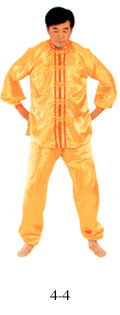
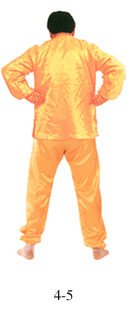
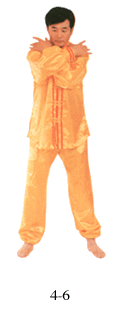
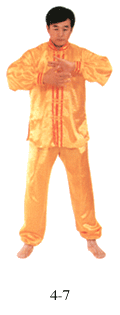
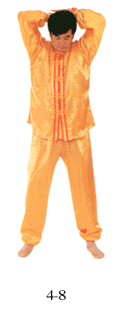
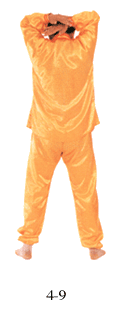
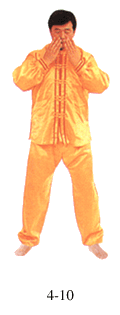
Overlap the hands in front of the lower abdomen (die kou xiao fu)
(Fig. 1-15), and then conjoin the hands in Jieyin
(Fig. 1-1).
5. Reinforcing Supernatural Powers
(Shentong Jiachi Fa)[43]
Principles:
Reinforcing Supernatural Powers is one of the serene
cultivation exercises in Falun Gong. It is a multi-purpose exercise intended
to strengthen supernatural powers (including supernatural abilities) and gong strength by turning the Law Wheel using Buddha
mudras, or “hand signs.” This exercise is above
the intermediate level and was originally kept as a secret exercise.
To fulfill the wishes of those who have reached a basic
level,I have specially made public this cultivation method to
save predestined practitioners. The exercise requires meditating in the
full-lotus position. The full-lotus position is preferable, though the
half-lotus position is also acceptable. During the exercise, the flow of qi is strong and the energy field around the body is
large. The hands move with the energy mechanisms planted by your shifu. When the hand
movements start, the heart follows the movement of the thoughts. When
strengthening the supernatural powers, keep the mind empty, with a slight
focus on both palms. The centers of the palms will feel warm, heavy, electric,
numb, as if holding a weight, etc. But don’t pursue any of these
sensations—just let them happen naturally. The longer the legs are crossed,
the better; it depends on one’s endurance. The longer you meditate, the more
intense the exercise is and the faster the energy grows. Don’t think about
anything when doing this exercise—no thought is involved—and ease into
stillness. Gradually enter into stillness from the dynamic state that seems
calm, but is not actually stillness. But your main consciousness must be aware
that you are doing the exercise.
Verse:
Youyi Wuyi[44]
Yinsui Jiqi[45]
Sikong Feikong[46]
Dongjing Ruyi[47]
Conjoin the Hands
(Liangshou Jieyin)
– Sit with legs crossed in
the lotus position. Relax the entire body, but don’t become too loose. Keep
the waist and neck upright. Tuck in the chin slightly. Touch the tip of the
tongue to the hard palate, leave a space between the teeth, and close the
lips. Gently close the eyes. Fill the heart with compassion. Assume a peaceful
and serene expression on the face. Conjoin the hands in Jieyin at the lower abdomen, and gradually enter into
stillness (Fig. 5-1).
First Mudra – When
the hand movements start, the heart follows the movement of the thoughts. The
movements should follow the energy mechanisms planted by your shifu. They should be carried out in an unhurried,
slow, and smooth way. Slowly raise both hands in the Jieyin position until reaching the front of the head.
Then, gradually turn the palms to face upward. When the palms are facing up,
the hands will have reached their highest point (Fig. 5-2). Next, separating
the hands, draw an arc over the head, turning them out to the sides until they
reach the front side of the head (Fig. 5-3). Immediately after, slowly lower
the arms. Try to hold the elbows inward, with palms facing up and fingers
pointing toward the front (Fig. 5-4). Next, straighten both wrists and cross
them in front of the chest. For males, the left hand goes outside; for
females, the right hand goes outside (Fig. 5-5). When a straight line is
formed by the arms and hands, rotate outward the wrist of the hand on the
outside, with the palm turned to face upward. Draw a semicircle, and turn the
palm to face upward with fingers pointing toward the back. The arm should use
some force. Turn downward the palm of the hand that was inside after crossing
in front of the chest. Straighten the arm. Rotate the arm and hand so the palm
faces outward. The arm in the lower front of the body should form an angle of
30° with the body (Fig. 5-6).



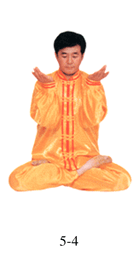
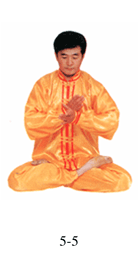
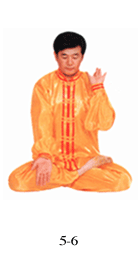
Second Mudra – Following from the previous position (Fig. 5-6), the
upper hand moves to the inside. Turn the palm of the upper hand toward the
body and simultaneously move the lower hand up. The movement is the same as in
the first mudra, with the left and right hands
switched. The positions of the hands should be exactly the opposite of before
(Fig. 5-7).
Third Mudra –
Straighten the right wrist for males (left for females) with the palm facing
the body. After the right (or left) hand moves across in front of the chest,
turn the palm to face down and move it down to the lower front where the shin
is located. Keep the arm straight. Males, turn the left wrist (females, the
right) while moving it up and passing the right hand with the palm facing the
body. At the same time, move the palm toward the left (females, the right)
shoulder. When the hand has reached its position, the palm faces up and the
fingers point forward (Fig. 5-8).
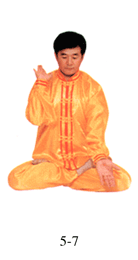
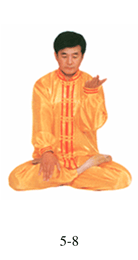
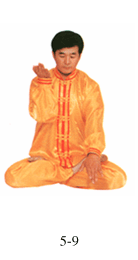
Fourth Mudra – This is the same mudra as
shown above, but with the hands in opposite positions. The left hand for males
(right for females) moves on the inside, and the right hand (left for females)
moves on the outside. The movements just switch the left with the right hand.
The hands are in opposite positions (Fig. 5-9). When doing all four mudras the movements are continuous, without
interruption.
Reinforcing Sphere-Shaped
Supernatural Powers – Continuing from the fourth mudra, the upper hand moves on the inside with the
lower hand moving on the outside. For males, the right palm (females, the left
palm) gradually turns and moves down toward the chest area. The left hand for
males (right for females) moves up. When both forearms reach the chest and
form a horizontal line (Fig. 5-10), pull the hands apart toward the sides
(Fig. 5-11) while turning the palms to face downward. When the hands extend
beyond the outsides of the knees, bring the hands to waist level, with the
forearms and the wrists at the same level. Relax the arms (Fig. 5-12). This
position draws internal supernatural powers out to the hands for reinforcing,
sphere-shaped supernatural powers. When supernatural powers are being
reinforced, the palms will feel warm, heavy, numb, as if holding a weight,
etc. But don’t pursue these sensations—let them happen naturally. The longer
the position is held, the better. Hold it until you are too tired to endure
it.
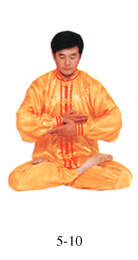
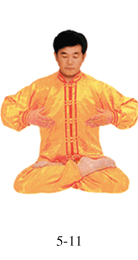
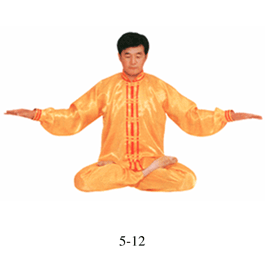
Reinforcing Pillar-Shaped
Supernatural Powers – Following from the previous position, rotate
the right hand (females, the left) so the palm faces upward and, at the same
time, move it toward the lower abdominal area. When the hand has reached its
position, keep the hand at the lower abdomen with the palm facing up. At the
same time, while that hand is moving, lift the other hand and simultaneously
move it toward the chin. Keep the hand as high as the chin and have the palm
face downward. The forearm and the hand should be at the same level. At that
time, both palms should face each other and stay in that position (Fig. 5-13).
That reinforces pillar-shaped supernatural powers, such as “palm thunder,”
etc. Hold the position until you feel that it is impossible to hold any
longer. Next, with the upper hand, draw a semicircle in front of you while
bringing the hand down to the lower abdominal area. Simultaneously lift the
lower hand until it is right below the chin while turning the palm to face
down (Fig. 5-14). That arm should be at the same level as the shoulder, with
the two palms facing each other. This strengthens the supernatural powers,
too, only with the opposite hand positions. Hold the position until the arms
become too tired to endure it.
Serene Cultivation
– From the last position, draw a semicircle downward with the upper hand, bringing the hand down to the lower abdominal area. Conjoin the hands
in Jieyin (Fig. 5-15) and start the serene
cultivation. Stay in stillness. The longer the better.
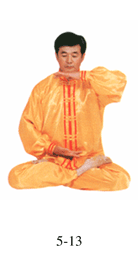
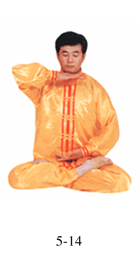
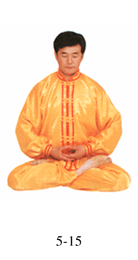
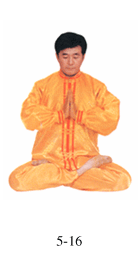
Ending Position –
Press the hands together in front of the chest in Heshi (Fig. 5-16). Come out of stillness and the lotus
position.
Basic Requirements and Points to Note for Falun Gong
Practice
1.
The five exercises of Falun Gong can be done
consecutively or selectively. But it is usually required that you begin with
the first exercise. Also, it is best to do the first exercise three times. Of
course, the other exercises may still be done without doing the first one.
Each one can be done on its own.
2. Each movement should be done accurately and with rhythm.
The hands and arms should move smoothly up and down, back and forth, left and
right. Following along with the energy mechanisms, move unhurriedly, slowly,
and smoothly. Do not move too quickly or too slowly.
3.
You must keep yourself under the control of your main
consciousness during the exercises, as Falun Gong cultivates the main
consciousness. Do not deliberately seek swaying. Restrain the swaying of the
body when it does occur. You may open your eyes if you have to.
4.
Relax the whole body, particularly the knee and hip
areas. If you stand too rigidly, the meridians will remain obstructed.
5.
During the exercises, the movements should be relaxed and
natural, free and unconstrained, easy and unencumbered. The movements should
be firm yet gentle, with some force yet no rigidity or stiffness. If this is
done the results will be more noticeable.
6. Every time you finish doing the exercises, you end the
movements but not the cultivation mechanisms. To end the exercises, you need
only to do Jieyin. Ending with the conjoined hands means the end
of the movements. Do not put an end to the cultivation mechanism using
intention, however, because the Law Wheel’s rotation cannot be stopped.
7. Those who are weak or chronically ill may practice
according to their conditions. They may do the exercises less or choose to do
any of the five. As to those who cannot perform movements, they may sit in the
lotus position instead. Whatever the situation, you should continue to
practice.
8. There are no special requirements in terms of location,
time or direction for the exercises. But a clean site and quiet surroundings
are recommended.
9. These exercises are done without using any directing with
thought, and that way you will never go awry. Do not mix Falun Gong with any
other system of cultivation. Otherwise, the Law Wheel will become
deformed.
10. When you find it really impossible to enter into
stillness during the exercises, you may chant your shifu’s name. As time passes, you will gradually be
able to enter into the state of stillness.
11. Some challenges may arise when doing the exercises. This
is one way of paying for karma. Everyone has karma. When you sense discomfort
in your body, do not consider it an illness. So that your karma may be
eliminated and the way for your cultivation paved, some hardships might come
soon or early.
12. If you cannot cross your legs for the meditation, you may
do it at first by sitting on the edge of a chair, and you can achieve the same result. But a practitioner must be able to do the lotus
position. Over time you will surely manage to do it.
13. If you see any images or scenes when doing the serene
exercises, pay no attention to them and go on with your practice. If you are
interfered with by some terrifying scenes or feel threatened, you should
immediately remember, “I am protected by Falun Gong’s teacher. I’m not afraid
of anything.” Alternatively, you may call out the name of Teacher Li and
continue on with your practice.
[1]
(pronounced “foah jahn chien-sho fah”)
[2]
The verses are recited once only, in Chinese, right before each exercise.
Each exercise has its own specific verse that you may recite out loud or just
listen to on the exercise tape.
[3]
(“shuhn-shuhn huh-ee”) The Mind and Body Join Together.
[4]
(“dong-jing sway-jee”) Move or Become Still According to the Energy Mechanisms.
[5]
(“ding-t’yen doo-zun”) As Tall as Heaven and Incomparably Noble.
[6]
(“chyen-shoh foah-lee”) The Thousand-Armed Buddha Stands Upright.
[7]
(“lyang-shoh jyeh-yin”)
[8]
(“mee-luh shuhn-yaow”)
[9]
(“tah tah-gah-tah”) A category of Buddha.
[10]
(“roo-lye gwahn-ding”)
[11]
(“shwahng-show huh-shr”)
[12]
The hand position to maintain throughout the exercises
whenever the hands are apart. In this position, the palms are open and the
fingers are relaxed, but straight. The middle finger of each hand is relaxed so
that it bends slightly towards the center of the palm.
[13]
(“jahng jrr chyen kun”)
[14]
(“jin-ho fun-shun”)
[15]
(“shwahng-long
shiah-high”)
[16]
(“poo-sah foo-lyen”)
[17]
(“loah-hahn bay-shahn”)
[18]
(“vudge-rah”) Here, this term refers to a Buddha’s warrior
attendants.
[19]
(“jin-gahng pie-shahn”)
[20]
(“dieh-koe sheeow-foo”)
[21]
(“fah-lun jwahng fah”)
[22]
(“shung-hway zung-lee”) Wisdom is Enhanced and Powers
Strengthened.
[23]
(“rong-shin ching-tee”) The Heart is Harmonized and Body
Lightened.
[24]
(“szz-meow szz-woo”) As if in a Wondrous and Enlightened
State.
[25]
(“fah-lun choo-chee”) The Falun Begins to
Rise.
[26]
(“toe-chien baow-lun”)
[27]
(“foo-chien baow-lun”)
[28]
(“toe-ding baow-lun”)
[29]
(“liang-tsuh baow-lun”)
[30](“gwahn-tong liang-jee
fah”)
[31]
(“jing-hwa bun-tee”) The Body is
Purified.
[32]
(“fah-kye ding-dee”) The Law Unlocks the Top and Bottom
Energy Passages.
[33]
(“shin-tszz ee-mung”) The Heart is Kind and the Will is
Strong.
[34]
(“tong-t’yen chuh-dee”) Reaching the Zenith of Heaven and
the Nadir of Earth.
[35]
(“dahn-show
chong-gwan”)
[36]
(“shwahng-show chong-gwan”)
[37]
(“shwahng-show tway-dong fah-lun”)
[38]
(“fah-lun jo-tyen fah”)
[39]
(“shwen-fah jhr-sheeu”) The Revolving Law Reaches the
Void.
[40]
(“shin-ching szz-yoo”) The Heart is Clear Like Pure
Jade.
[41]
(“fahn-bun gway-juhn”) Returning to Your Original, True
Self.
[42]
(“yo-yo szz-chee”) You Feel Light, as if
Floating.
[43]
(“shun-tong jya-chr fah”)
[44]
(“yo-ee woo-ee”) As if With Intent, Yet Without
Intent.
[45]
(“yin-sway jee-chee”) Hand Movements Follow the Energy
Mechanisms.
[46]
(“szz-kong fae-kong”) As if Empty, Yet Not
Empty.
[47]
(“dong-jing ru-yee”) Move or Become Still With
Ease.